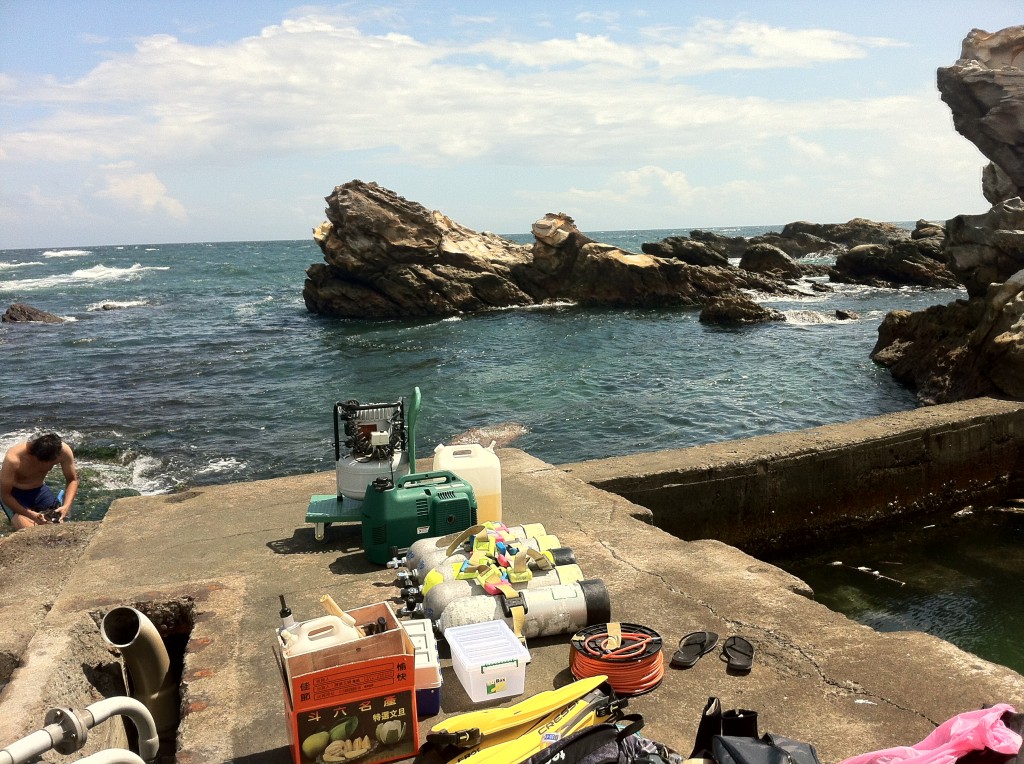For most Americans, it seems a little sunburn is just a part of summer. I have thankfully avoided it pretty well throughout recent years but, Friday destroyed that streak of careful living for me. The research group that I am joining took a collective trip to the ocean side, which is both as easy as you’d expect when you are on a small island but also as long of a trip as could be expected when said island is full of jagged-relief mountain peaks (lots of tunnels and bridges seem to be involved with driving around from what I’ve seen so far).
To be honest, I wasn’t really sure what to expect from the trip to start out with. This is the email that I got:
“Dear all,
Summer is coming to an end and Kiribati is waving viciously, so…we’ll be prepared to conquer! On the 14th of Sep. 0900 sharp our well-equipped-trained troop will gather at the front yard of our lab.
Destination: The most dangerous rocky shore in the Northeastern Taiwan.
Goal: For the warriors, to prove our state-of-the-art weaponry are functioning and get a core out of the largest coral if there ever is. (so help me God)
For the cheerleaders, exercise as much as you can, have fun and get yourselves well tanned.
Kind reminder, for those who with delicate skin, you might like to wear long sleeves and pants instead of bikini if you don’t want to be cut by dead coral or seashell. Fresh water available and changing clothes possible.
At ease and cheers!”
So clearly the purpose of the trip was some parts work, but also some parts fun. Turned out to be a LOT of fun, and a rather unfortunately small amount of work. It was raining pretty hard in Taipei when we loaded the equipment (diving tanks, generator, air compressor, wetsuits, fruit for snacking that I still don’t know the name of – this is going to be a common trend – coral driller…) into the back of a van and a cheerful group of people into the front. The rain and the cold front with it represent the start of the winter season, commented someone with a PhD in an earth science. But thankfully the weather was also highly patchy, as predicted by the same scientist (a meterological trait of Taiwan, due to the mountains). By the time that we reached the coast, the sun was full, and warm winds blew around us on the rugged (as promised), but beautiful rocky shore of northern Taiwan.

We spent the day in a small outcropping near some shellfish aquaculture pens, testing diving equipment and drillers for taking core samples; but also jumping off rocks, and swimming. Unfortunately, the air compressor for the drilling equipment wasn’t working so well, so very little testing of the corer actually occurred. Instead, there I did get a chance to learn how to use scuba diving equipment – which was great!
As morning waned into afternoon, we packed up our stuff, changed (except that I didn’t actually bring much in the way of a change of clothes, oops) and then headed out to find a late lunch. We stopped at Jiufen, which we had driven past on the way up.

Jiufen is a small town perched atop beautiful mountains that rise right next to the coast. There was once a mining boom, which still influences the area. One of the most obvious influences that we had a chance to stop and observe was a tributary carrying acid mine drainage out to the ocean. The plume of water is so low in pH (1-2) that iron compounds are soluble. When the water begins to mix with the ocean and the pH is raised, the iron precipitates, and appears as a dark red-brown plume. This makes it easy to see how the plume’s length and characteristics vary based on the tides.

Now, Jiufen is a tourist attraction, originally sparked by a movie that featured it, but obviously sustained because of its beauty, idyllic nature, and good eats, of course. We ate, some of us climbed to the mountain peak near where we parked (which I have already forgotten the name of – so many mountains!) and headed home as the fog and rain descended once more.


At some point in the car, I asked, “Hey, why is it called ‘jiufen’ anyway?” Jiufen, or 九份literally means ‘nine parts’. No one really knew, nor had thought much about it – so a smart phone was whipped out and the internet was consulted. Everyone found the answer supplied online to be amusing, but, as is sort of typical of my level of Chinese right now, I didn’t really understand what was read (if it’s humorous, I usually don’t get it). Well, the English Wikipedia article says “During the first years of the Qing Dynasty, the village here housed nine families, thus the village would request “nine portions” every time shipments arrived from town…” which doesn’t sound all that funny to me, so I wonder if there’s a different explanation spread around in Chinese…

